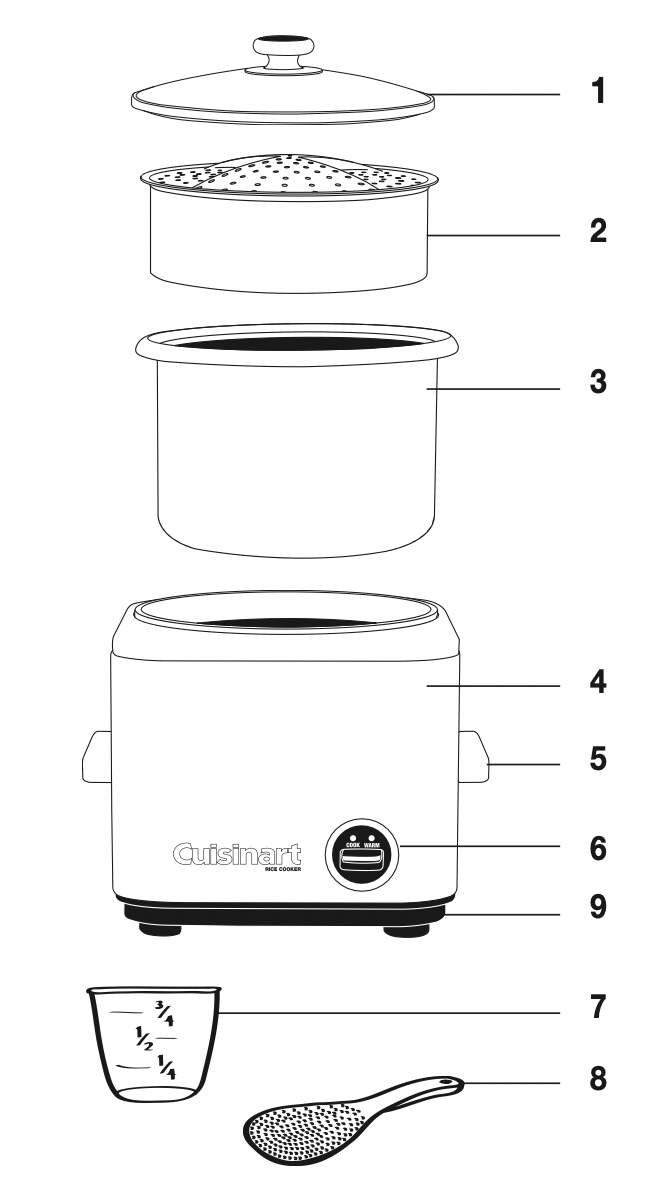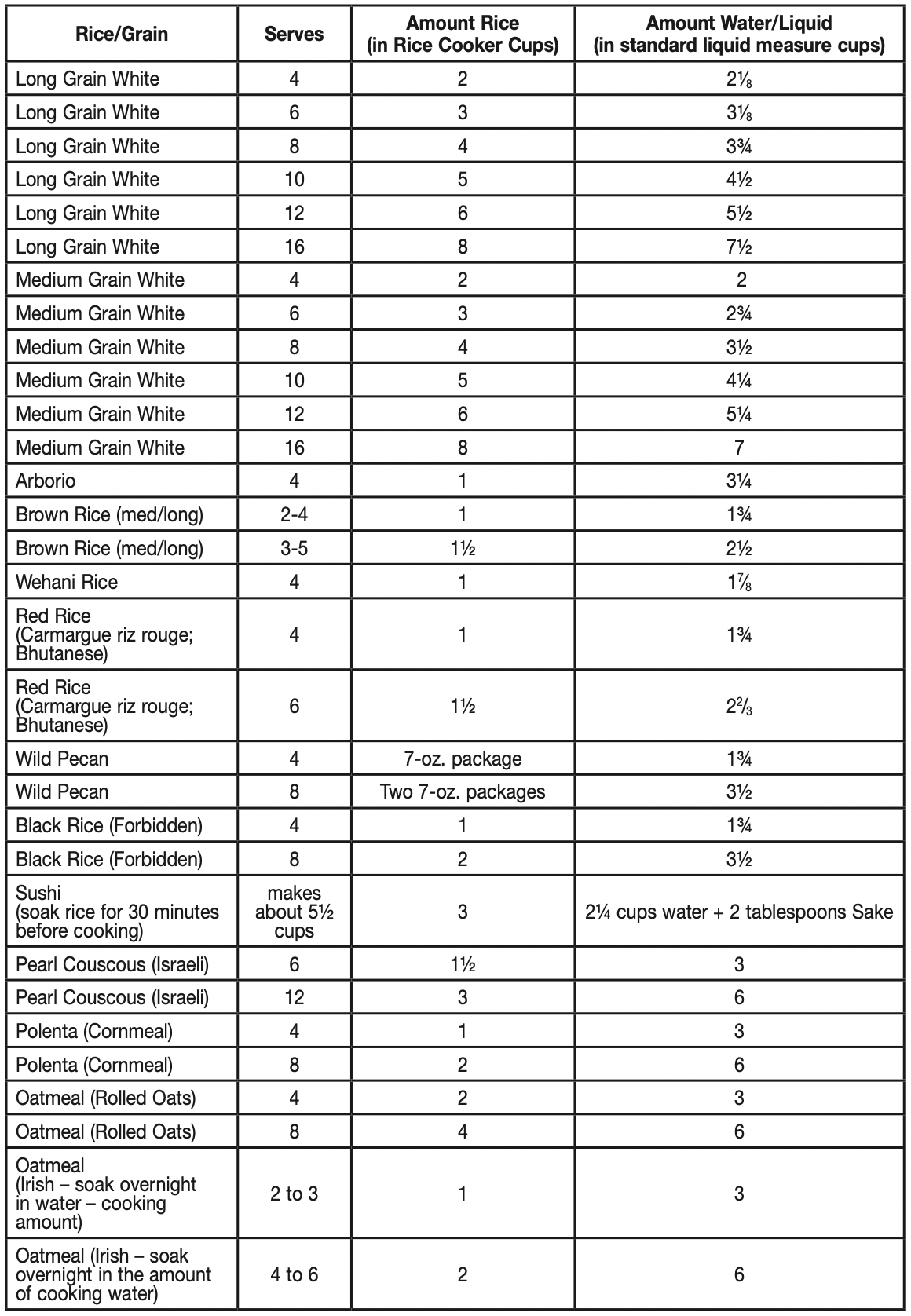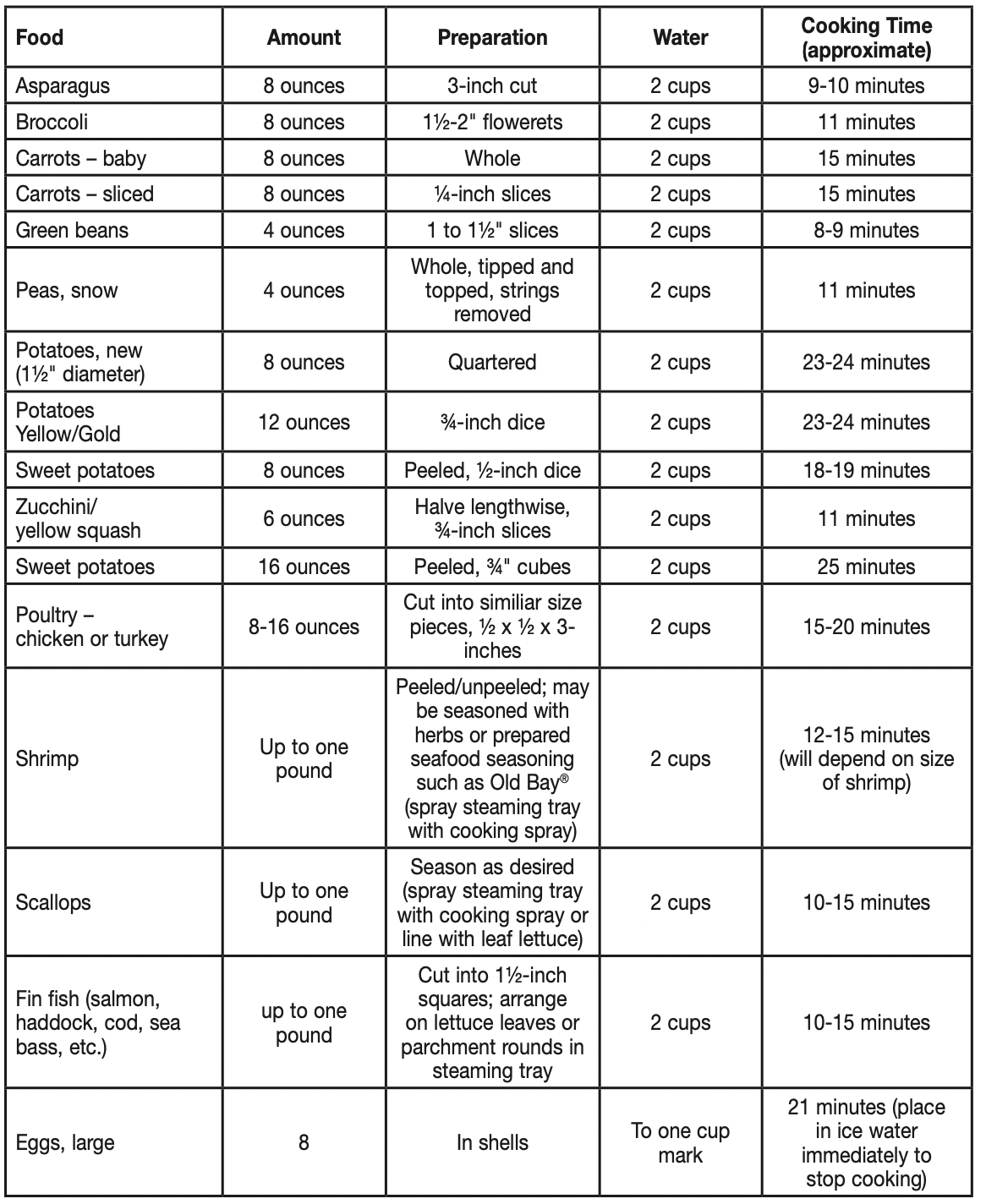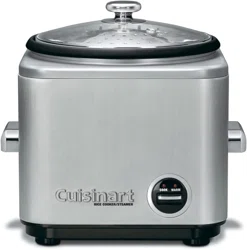Documents: Go to download!
User Manual
- User Manual - (English)
- Product Documentation - (English)
- PARTS AND FEATURES
- IMPORTANT GUIDELINES
- TIPS AND HINTS
- ASSEMBLY INSTRUCTIONS
- OPERATION
- CLEANING AND CARE
- COOKING CHARTS
Table of contents
Owner Guide Rice Cooker/Steamer
PARTS AND FEATURES

- Glass Lid w/Stainless Steel Rim and Steam Vent: See-through glass lid allows you to view the rice while the steam vent helps to prevent splattering. Stainless steel rim accents complement any kitchen decor.
- Steaming Tray: Allows you to steam a variety of foods while the rice is cooking.
- Cooking Bowl: Nonstick coating prevents the rice from sticking to the bowl.
- Stainless Steel Housing: Durable stainless steel construction makes cleanup easy.
- Chrome-plated Handles: Cool touch handles.
- “Cook” and “Warm” Indicator Switch: LED lights on top of the switch indicate that the unit is in Cook or Warm mode.
- Measuring Cup: Calibrated specifically for your Cuisinart ® Rice Cooker/Steamer; allows you to measure the proper rice to water proportions with ease.
- Rice Paddle: Allows you to fluff and scoop the rice out of the cooking bowl. Rice won't stick to the utensil.
- Retractable Cord Storage (not shown): Convenient retractable cord storage.
IMPORTANT GUIDELINES
- This appliance generates steam. Do not operate it without the lid in place.
- Do not use your Rice Cooker/Steamer under hanging wall cabinets; the escaping steam could cause damage.
- Do not use metal utensils. Metal utensils will damage the nonstick finish on inner cooking bowl.
- Do not plug in the cooker before rice and water have been added. Because the Rice Cooker/ Steamer does not have an Off setting, the unit will automatically be in Warm mode immediately after the unit is plugged in.
TIPS AND HINTS
- The Cuisinart ® Rice Cooker/Steamer is a perfect appliance for a busy lifestyle and limited space.
It will cook rices and grains perfectly with minimal fuss, taking up little counter space and leaving all your burners free for other tasks. Cleaning up the nonstick bowl is quick and easy and there is virtually no maintenance. - Your rice cooker can be used for more than just plain old rice. It is a simple way to cook pilafs. Simply turn unit on and walk away — it will automatically switch to Warm when ready to serve.
- You can use your rice cooker to cook a combination of rice, grains and legumes at the same time. Follow our recipes for ideas and suggested amounts to use — let your imagination be your guide.
- Rinsing/washing rice: Generally the rule is to wash or rinse imported rice and not to wash or rinse domestic (grown in U.S.) rices, as they have been enriched with vitamins. To wash rice: place in a medium bowl and cover with water, swirl until the water appears chalky/cloudy, and drain in a fine mesh strainer. Repeat until water is clear (or nearly clear) when rice is covered and swirled. Rice aficionados will even wash domestic rice, as it removes the starches and reduces stickiness.
If you follow a well-balanced diet, then the loss of these vitamins will not be detrimental. Do not wash your rice in the rice cooker bowl – if the outside of the bowl is wet when cooking, it may cause damage to your rice cooker. - Some rices may call for a soaking period. This can be done in the rice cooker bowl prior to cooking.
- When cooking rice, boil it until it has absorbed all the liquid. At this time it is not quite done. Rice benefits from a “boil-steam” method of cooking. Allow your rice to rest on the Warm setting for 5 to 10 minutes before serving for best results. Do not remove the cover and peek.
- After rice rests for 5 to 10 minutes, open rice cooker cover and stir rice gently with rice paddle or a wooden spoon. If rice is not ready to serve, re-cover and let stand on Warm until ready.
- The rice cooker will switch to the Warm cycle when it has finished cooking. At this time, you may stir in chopped raw vegetables such as green onions, slivered snow peas, shredded carrots, or even grape tomatoes to add texture to the dish – they will warm while the rice is resting, and if served in 5 to 10 minutes will retain their unique texture.
- The rice cooker can be used to prepare commercially packaged pilafs, rice and grain mixes. Some packages will come with generic rice cooker instructions, or they may be found on the websites of the manufacturers. If the package has a sautéing step, do it right in the rice cooker bowl. Turn on, add specified amount of butter or oil, add rice/vegetables/meat and sauté according to package instructions, with the lid on. Add liquid and continue to cook. If the rice is too wet, allow it to remain on Warm for 15 to 20 minutes before serving. If it is too chewy, add up to 1/4 cup more liquid and let stay on Warm until liquid is absorbed (about 15 to 20 minutes).
- When measuring rice with your rice cooker cup, level it off with a table knife or spatula as you would flour for baking.
- If desired, you may spray your rice cooking bowl with nonstick cooking spray, but this step is not necessary, as it has a nonstick coating.
- When rice is placed in the cooking bowl, level it off to a flat layer that covers the entire bottom of the bowl, to ensure that it cooks evenly.
- The water you use for cooking rice should be the same water that you drink. If you do not like the taste of your tap water, use bottled or filtered water. The taste of the water will affect the taste of the rice.
- For best results, use cold water. Cooking times will vary depending on the temperature of the water being used.
- Liquids other than water may be used to cook rice. Use low-fat, low-sodium meat or vegetable stocks/broths. Fish stock or clam broth may be used for seafood-flavored rice.
- One to two teaspoons of unsalted butter, olive, vegetable or nut oil will help keep grains of rice separate and prevent boiling over.
- If your recipe calls for salt, add and swirl in with the rice paddle or a wooden spoon after adding liquid — then level the rice as evenly as possible.
- The rice cooker can be used to steam vegetables, seafood and some meats while cooking the rice. Use our recipes as a guide, then create your own combinations.
- When steaming vegetables, clean them and trim to similar size. Follow Steaming Guide (page 7) for steaming vegetables alone. To steam vegetables while preparing rice, use steaming guide to time when to add vegetables to steaming tray.
Most vegetables can be added about 10 minutes before rice has finished cooking. - When steaming meats such as poultry or sausage, cut all into small, similar sized pieces (such as “finger strips” or 1-inch slices). Arrange in a single layer in the steaming tray, which has been sprayed with cooking spray.
- When steaming shrimp, scallops and other seafood, arrange in a single layer in the steaming tray, which has been sprayed with cooking spray.
- When using your rice cooker, plug it in and arrange it on the counter away from the wall and not under hanging cabinets, to prevent steam damage.
- The steam vent in the cover should always be placed facing the back of the rice cooker. Lift the lid from the back to the front to prevent steam burns.
- One cup of uncooked rice makes approximately three cups of cooked rice.
- 1 rice cooker cup (filled to the top) = ¾ cup = 12 tablespoons
ASSEMBLY INSTRUCTIONS
To use your Cuisinart ® Rice Cooker/Steamer:
- Carefully unpack the cooker.
- Rinse the nonstick cooking bowl, steaming tray and lid in warm, soapy water. Rinse well and dry thoroughly.
- Wipe all interior and exterior surfaces of the rice cooker base with a soft, damp cloth.
- Place cooking bowl in base of unit.
- Place steaming tray in cooking bowl with open part facing down.
- Place the lid on top of the cooking bowl.
- Do not plug in unit. Your rice cooker is now ready for use.
OPERATION
Cooking Rice
- Make sure your Cuisinart ® Rice Cooker/Steamer is unplugged.
- Place cooking pot in the stainless steel housing.
- Measure desired amount of raw rice with the measuring cup provided. Rinse rice if needed. See Guide for Cooking Rice (page 6) for rice-to-water ratios.
- Choose one of the following ways to add water or stock for cooking:
a. Using the measuring cup provided for rice, measure the appropriate amount of water using standard liquid measuring cup. See Guide for Cooking Rice.
b. Using the water line inside the cooking pot, add water to the rice inside the bowl up to the proper water line. For example, if you added 2 cups of raw rice, add water to line 2 (white rice only). - Cover the cooking bowl with lid. Make sure the steam vent is facing toward the back of the unit.
- Plug in unit.
- Set to the cook position by pressing the switch down. The Cook LED light will be illuminated.
- Rice cooker will heat and cook the rice.
Cooking time will vary, depending on the amount and type of rice or grain being cooked. - Once the rice is cooked, the unit will automatically switch to the Warm setting and the Warm LED will be illuminated. The unit will stay in Warm mode until the unit is unplugged from the outlet.
- For best texture, allow cooked rice to rest in Warm mode for 5 to 10 minutes.
- Once you are ready to serve the rice, lift the lid away from you.
- Fluff rice with paddle or utensil suitable for nonstick cookware.
- Lift and remove cooking bowl from rice cooker using potholders.
Cooking Rice and Steaming
- Clean and prepare your vegetables, seafood, fish or poultry.
- Follow steps 1 to 8 under the Cooking Rice section (page 4).
- Fill the steaming tray with open end facing up.
- Place the filled steaming tray on top of the cooking bowl at the appropriate time for food being steamed. See Steaming Guide (page 7), for approximate cooking times.
- Place lid on top of the steaming tray.
- When the appropriate cooking time has elapsed, unplug the unit.
Steaming Only
- Make sure unit is unplugged.
- Fill cooking bowl with the suggested amount of water based on the Steaming Guide.
- Fill the steaming tray with open end facing up.
- Place the filled steaming tray on top of the cooking bowl.
- Place lid on top of the steaming tray.
- When water is completely evaporated, the unit will automatically switch to the Warm setting and the Warm LED will be illuminated. The unit will stay in Warm mode until the unit is unplugged from the outlet. Do not allow bowl to boil dry.
- For best results, unplug unit immediately after the unit switches to Warm, to prevent over-cooking.
Reheating Rice
- Make sure unit is unplugged.
- To reheat rice, add 1/4 cup (4 tablespoons) of cold water per cup of cooked rice.
- Stir to mix.
- Place lid on top of the cooking bowl.
- Plug in unit and set to the cook position by pressing the switch down. The Cook LED light will be illuminated.
- Once the rice is cooked, the unit will automatically switch to the Warm setting and the Warm LED will be illuminated. The unit will stay in Warm mode until the unit is unplugged from the outlet.
CLEANING AND CARE
- Unplug your Cuisinart ® Rice Cooker/Steamer and allow it to cool before cleaning.
- Place cooking bowl, steaming tray and lid in the dishwasher or wash with warm, soapy water. If food sticks to the surface, fill with warm, soapy water and allow to soak before cleaning.
- If scouring is necessary, use a nonabrasive cleanser or liquid detergent with a nylon pad or brush.
- Wipe base of unit with a soft, damp cloth or microfiber towel. NEVER IMMERSE BASE OF UNIT IN WATER.
- Make sure all parts are cool before storing. Store unit in a clean, dry place.
COOKING CHARTS
Guide for Cooking Rice (see chart, next page)
Cooking times will vary according to amount and temperature of cooking liquid.
The simplest way to cook long grain (converted) white rice is to place rice in cooking bowl and add liquid to appropriate line marking. For example, using the rice measuring cup provided, fill cooking bowl with 2 cups rice. Then, add water to the 2 cup water marking inside the bowl. If using 3 cups of rice, add water to the 3 cup water marking inside the pot. Do the same when using 4 to 8 cups of rice. Please note that preparing less than 2 cups of rice is not recommended.
For grains or brown and specialty rices, use the chart provided below. Note that you should not prepare these in amounts smaller or larger than stated in the chart.
All rice/grain is measured in the rice cooker cup. All water/liquid is measured in a standard liquid measuring cup.
Guide for Cooking Rice

Guide for Steaming Vegetables, Poultry, Seafood and Hard-Cooked Eggs
Place indicated amount of water into the Cooking Bowl. The amount needed will vary according to the type of food being cooked. Arrange foods in a single layer in the steaming tray. Vegetables should be cut in similar sizes as indicated. Begin timing when unit is turned on. Cooking times are approximate and will yield cooked but crisp/tender vegetables. Add more time for more tender/softer vegetables or cut back on time for crispier vegetables to taste.
Rice cooker must be unplugged immediately after vegetables have finished cooking to prevent overcooking. If cooking vegetables over rice, use chart to determine approximately when to add steaming tray to rice cooker. Serve steamed vegetables immediately or plunge into ice water to stop cooking to use in salads and other cold preparations.

See other models: CMW-200 CTK-EOS1R SM-55 CTK-EOSTRBK SM-70
